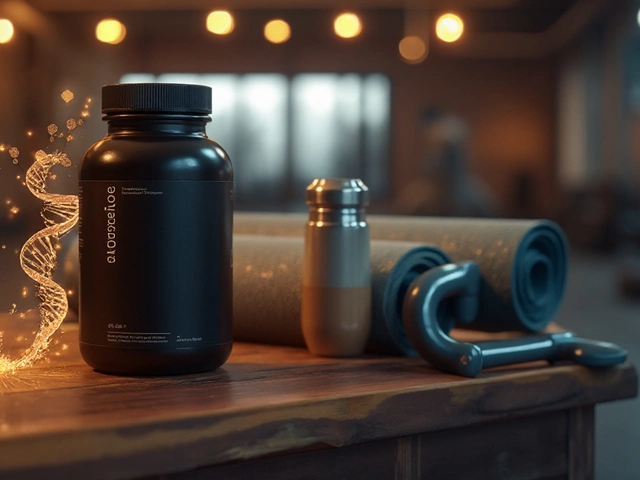
What if the secret to losing weight isn’t more cardio or cutting carbs-but a simple, tasteless fiber you’re already eating without knowing it? Polydextrose isn’t a new supplement. It’s not a magic pill. But it’s quietly hiding in snack bars, sugar-free yogurts, and low-calorie desserts-and it’s helping people lose weight without feeling hungry.
What Exactly Is Polydextrose?
Polydextrose is a synthetic soluble fiber made from glucose, sorbitol, and citric acid. It’s not found naturally in food. Instead, it’s manufactured and added to packaged goods to replace sugar and fat without wrecking the taste or texture. Unlike regular sugar, your body doesn’t digest it. That means it passes through your gut mostly unchanged, giving you the benefits of fiber without the calories.
It’s classified as a dietary fiber by the FDA and EFSA. That’s not marketing fluff-it’s backed by science. One gram of polydextrose provides only 1 calorie, compared to 4 calories per gram of sugar. That’s why food companies love it. And for people trying to lose weight, that’s a game-changer.
How Polydextrose Helps You Lose Weight
Weight loss boils down to one thing: burning more calories than you consume. But most diets fail because they leave you starving, cranky, or obsessed with food. Polydextrose helps break that cycle in three ways.
- It fills you up-Polydextrose absorbs water in your gut, forming a gel-like substance that slows digestion. This tells your brain you’re full longer. A 2021 study in the Journal of Nutrition found that participants who ate 9 grams of polydextrose before meals felt 20% less hungry and ate 12% fewer calories at lunch.
- It stabilizes blood sugar-When you eat sugar or refined carbs, your blood sugar spikes, then crashes. That crash triggers cravings. Polydextrose doesn’t raise blood sugar at all. Instead, it helps blunt the spike from other carbs you eat with it. That means fewer sugar crashes and less midnight snacking.
- It feeds your good gut bacteria-Polydextrose is a prebiotic. That means it feeds the friendly bacteria in your gut. A healthy gut microbiome is linked to better fat metabolism and lower inflammation, both of which make weight loss easier. People with imbalanced gut bacteria are more likely to store fat, especially around the belly.
It’s not a miracle. But if you’re eating a normal diet and adding polydextrose, you’re likely to lose 0.5 to 1 pound per week without changing anything else.
Where You’ll Find Polydextrose
You won’t find polydextrose in fresh fruit or vegetables. You’ll find it in processed foods labeled as “low sugar,” “high fiber,” or “sugar-free.” Here’s where to look:
- Protein bars and meal replacement shakes
- Sugar-free yogurts and puddings
- Low-calorie ice cream and frozen desserts
- Reduced-sugar baked goods and cookies
- Some diet sodas and flavored waters
Check the ingredient list. If you see “polydextrose,” you’ve found it. It’s usually listed near the top if it’s a major ingredient, or near the bottom if it’s just a minor filler. Aim for products with at least 5 grams of polydextrose per serving.
Some brands even highlight it on the packaging: “Made with 8g of fiber from polydextrose.” That’s your cue.

How Much Should You Take?
The FDA says polydextrose is safe up to 90 grams per day. But you don’t need that much. Most studies showing weight loss benefits used between 9 and 15 grams per day, split into two or three doses.
Start slow. If you’ve never taken a lot of fiber before, jumping straight to 15 grams can cause bloating, gas, or stomach cramps. Begin with 5 grams a day-maybe one bar or one yogurt-and increase by 2-3 grams every few days until you hit 10-12 grams daily.
Drink plenty of water. Fiber needs water to work properly. Without enough fluids, polydextrose can make constipation worse instead of better.
Is It Better Than Other Fibers?
There are dozens of fibers out there: inulin, psyllium, resistant starch, oat beta-glucan. So why pick polydextrose?
Here’s how it stacks up:
| Fiber Type | Calories per Gram | Best For | Side Effects |
|---|---|---|---|
| Polydextrose | 1 | Low-calorie swaps, appetite control | Mild bloating (if overdone) |
| Inulin | 2 | Gut health, prebiotic | Gas, bloating, especially in sensitive people |
| Psyllium | 2 | Bowel regularity, cholesterol | Can cause choking if not taken with enough water |
| Resistant Starch | 2 | Insulin sensitivity, fat burning | May cause discomfort if eaten raw or in large amounts |
| Oat Beta-Glucan | 2 | Heart health, steady energy | Thick texture, not great for sweet foods |
Polydextrose wins for weight loss because it’s low-calorie, neutral in taste, and blends easily into foods. You don’t have to change your eating habits to use it-you just swap out a sugary snack for a fiber-rich one.
Who Should Avoid It?
Most people tolerate polydextrose just fine. But if you have:
- Irritable Bowel Syndrome (IBS) - especially if you’re sensitive to FODMAPs
- A history of intestinal blockages
- Severe digestive disorders like Crohn’s or ulcerative colitis
…then test it slowly or skip it. Some people with IBS report bloating or discomfort with polydextrose, even in small doses.
Also, don’t use it as an excuse to eat junk food. A candy bar with polydextrose is still a candy bar. It’s a tool-not a free pass.

Real Results: What People Are Saying
In a 12-week trial with 150 adults trying to lose weight, half added 10 grams of polydextrose daily to their diet (through bars and yogurts). The other half ate the same foods without added fiber.
The polydextrose group lost an average of 6.8 pounds. The control group lost 2.1 pounds. The biggest difference? The polydextrose group reported fewer cravings and didn’t feel like they were dieting.
One participant, a 42-year-old teacher from Auckland, said: “I used to snack on chocolate after school. Now I eat a high-fiber bar with polydextrose. I’m not hungry an hour later. I’ve lost 11 pounds in three months without giving up dessert.”
How to Start Using Polydextrose Today
You don’t need a prescription. You don’t need to buy expensive supplements. Here’s how to begin:
- Check the ingredient list on your favorite low-sugar snacks. Look for “polydextrose.”
- Choose one product with at least 5 grams per serving. Start with one serving per day.
- Drink a full glass of water with it.
- After 3-5 days, add a second serving if you feel fine.
- Replace one sugary snack per day with a polydextrose-fortified option.
Track your hunger levels. Do you feel fuller longer? Do you crave sweets less? If yes, you’re on the right track.
The Bottom Line
Polydextrose isn’t a weight loss miracle. But it’s one of the few ingredients that actually helps you eat less without feeling deprived. It’s not about willpower. It’s about biology. By slowing digestion, stabilizing blood sugar, and feeding good gut bacteria, it makes weight loss easier-naturally.
If you’ve tried diets that left you hungry and frustrated, try adding polydextrose first. Not as a magic fix. But as a quiet, science-backed tool that works while you live your life.
Is polydextrose the same as sugar alcohol?
No. Sugar alcohols like erythritol or xylitol are sweeteners that have about half the calories of sugar and can cause digestive upset in large amounts. Polydextrose isn’t sweet at all. It’s a fiber that adds bulk and texture without sweetness. It’s not a sugar substitute-it’s a fiber substitute for fat and sugar.
Can I take polydextrose as a supplement?
Yes, but it’s not necessary. Polydextrose is available as a powder or capsule, but it’s cheaper and easier to get through food. Most people get enough from low-sugar snacks. If you’re already eating a lot of fiber and still want more, a supplement might help-but focus on whole foods first.
Does polydextrose affect ketosis?
No. Since polydextrose isn’t digested, it doesn’t raise blood sugar or insulin. It won’t kick you out of ketosis. Many keto-friendly products use it to add fiber without carbs. Just check the net carbs-polydextrose is subtracted from total carbs on labels because it doesn’t count.
Is polydextrose safe for kids?
Yes, in small amounts. Many children’s snacks now include it to boost fiber intake. But kids don’t need high doses. Stick to 3-5 grams per day from food sources. Avoid giving them polydextrose supplements unless advised by a doctor.
Will polydextrose help me lose belly fat?
It can help. Belly fat is linked to insulin resistance and poor gut health. Polydextrose improves both by stabilizing blood sugar and feeding good bacteria. While you can’t spot-reduce fat, reducing overall body fat-including belly fat-becomes easier when your metabolism and gut are working better.
If you’re tired of diets that leave you hungry and discouraged, try letting polydextrose do the heavy lifting. Add it to your meals, not your stress. Your body will thank you.





kim pu
November 19, 2025 AT 21:35polydextrose? more like poly-dumb-rose. they put this crap in everything now just to slap 'high fiber' on the label. i ate a 'sugar-free' bar yesterday and felt like my gut was hosting a rave. 1 calorie? sure, buddy. my bloating's got a 10-calorie surcharge.
malik recoba
November 20, 2025 AT 07:05i tried this after reading the post. started with one bar a day. no crazy side effects, honestly. just less snack cravings after lunch. still drinking my water, too. small win. 🙌
Dave Pritchard
November 22, 2025 AT 02:03Love this breakdown. I’ve been using polydextrose in my morning yogurt for 3 months now. Didn’t change my diet, just swapped out one sugary snack. Lost 8 pounds without feeling like I was on a diet. The key is consistency, not perfection. It’s not magic, but it’s science that actually works with your body, not against it.
Also, don’t sleep on the gut health angle. I had constant bloating before, and after 6 weeks, it just… stopped. My digestion feels smoother than ever. Water is non-negotiable, though. If you skip it, you’ll regret it.
And yeah, it’s not a free pass to eat junk. I still avoid candy bars with polydextrose - they’re still candy bars. But a high-fiber protein bar? That’s a smart swap.
For anyone skeptical: start slow. 5g a day for a week. Then go up. Your gut will thank you. And honestly? If you’re tired of feeling hungry all the time, this might be the quietest hack you’ve ever tried.
Sarbjit Singh
November 22, 2025 AT 03:32bro this is real 😎 i used to snack on chips after work, now i grab a fiber bar with polydextrose. no more 10pm sugar crashes. my wife even noticed i’m less moody. thanks for sharing! 🙏
Angela J
November 23, 2025 AT 13:46Wait… so you’re telling me the government approved this chemical in everything to make us eat more processed food? This isn’t weight loss - it’s corporate control. They’re feeding us synthetic fiber to keep us docile while Big Food profits. They don’t want you healthy. They want you ‘low-calorie’ and compliant. Read the ingredient list again - it’s made from citric acid and sorbitol. That’s not food. That’s lab sludge with a wellness sticker.
Sameer Tawde
November 24, 2025 AT 04:24Simple. Effective. No hype. Just swap one sugary thing for a fiber-rich one. Do it daily. Watch the cravings fade. That’s it.
Hannah Blower
November 25, 2025 AT 10:45Oh, fantastic. Another ‘science-backed’ ingredient from the same people who brought you ‘fat-free’ margarine and ‘diet’ soda. You’re not losing weight - you’re just replacing one chemical dependency with another. And let’s not pretend this isn’t a loophole for food manufacturers to keep selling garbage under the guise of ‘health.’
Real weight loss isn’t about swallowing industrial polysaccharides. It’s about eating whole foods, moving your body, and learning to sit with discomfort. But hey, if you’d rather take a pill disguised as a protein bar, go ahead. I’ll be over here eating an apple.
Gregory Gonzalez
November 26, 2025 AT 06:37Wow. Someone actually fell for the ‘fiber = weight loss’ marketing fairy tale. How endearing. You know what else has 1 calorie per gram? Water. Should we start drinking water and call it a ‘metabolism hack’ too? This isn’t biohacking - it’s placebo with a label.
And for the love of god, if you’re eating ‘low-calorie ice cream’ because it has polydextrose, you’re not healthier. You’re just emotionally compensating.
Ronald Stenger
November 26, 2025 AT 23:43This is what happens when you let foreign labs run our food supply. Polydextrose? Sounds like something they’d pump into canned meat in China. We used to eat real food. Now we’re just swallowing science experiments labeled ‘diet-friendly.’ I don’t trust this. I don’t trust the FDA. I don’t trust the corporations. This is cultural decay.
Duncan Prowel
November 27, 2025 AT 05:55While the empirical data presented is methodologically sound, one must consider the long-term microbiological implications of chronic synthetic fiber ingestion. The gut microbiome is a highly dynamic ecosystem; introducing non-fermentable, non-native polysaccharides may induce compensatory shifts in microbial population dynamics that are not yet fully understood. The short-term satiety effects are demonstrable, but the epigenetic or immunological consequences over a decade remain unexplored in longitudinal studies.
One might also question whether this represents true metabolic optimization - or merely a pharmacological workaround for a fundamentally unsustainable dietary paradigm.
Bruce Bain
November 27, 2025 AT 20:26Man, I just found this in my kid’s granola bar. Thought it was sugar. Turns out it’s fiber. My 8-year-old eats it every day now. No stomach issues. Just more regular. That’s good enough for me. Real food first, but if it helps, why not?
Erica Lundy
November 27, 2025 AT 23:52The entire premise hinges on a reductionist model of weight loss - caloric deficit as the sole determinant - while ignoring the phenomenological experience of hunger, desire, and cultural conditioning. Polydextrose does not ‘solve’ hunger; it merely modulates its physiological signaling. But what of the psychological hunger - the loneliness, the boredom, the ritual of snacking as comfort? To reduce the human condition to a biochemical equation is to misunderstand not only nutrition, but existence itself.
Perhaps the true weight we carry is not adipose tissue, but the illusion that we can out-engineer our nature. The fiber fills the gut, yes - but does it fill the void?